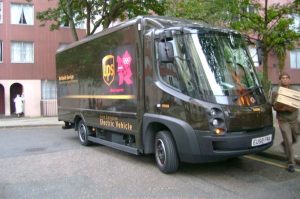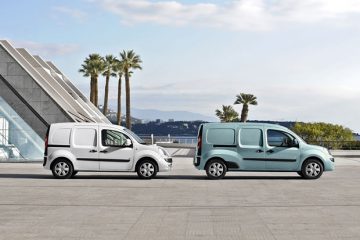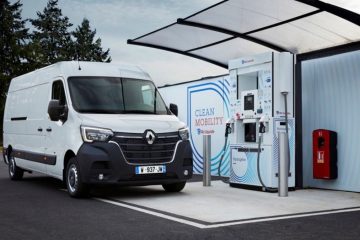A transformation of the logistics transportation industry is underway and our future looks bright with smart solutions and sustainable alternatives. Companies need to stay competitive and add new advanced technologies to improve the management of their distribution centers, warehouses, shipments and transportation.
The five technology trends affecting logistics transportation

Source :
London Permaculture
https://www.flickr.com/photos/naturewise/5086134410/
We are living in a disruptive period thanks to the contributions of technology. Logistics and transportation is an important sector of the economy. Therefore, it is important to see how to integrate these technologies into this sector.
The Blockchain
An emerging technology – a decentralized distributed technology specifically designed to transform business operations, record transactions, track assets and create a transparent and efficient system to manage all documents involved in the logistics process.
Technology based on a tool from a branch of mathematics called cryptography enables the monitoring of the performance history of carriers and other suppliers. Smart contracts are a huge time and money saver. Improves supply chain security, including reducing fraud, bottlenecks and errors, third-party certification and increasing efficiency.
Internet of Things, loT
The Internet of Things is an ecosystem of internet-connected smart devices with processors, sensors, and communication hardware. Data is collected and smart sensors, cars and trucks can alert vehicles of potential hazards.
IoT-equipped trucks with real-time driving, mapping and video data. Smart vehicles will be able to detect blind turns and turns at a certain distance, identify pedestrians, cyclists and other road hazards.
It will revolutionize transportation, reduce accidents by 80 percent and improve the visibility of global manufacturing networks.
Drivers using loT technology can monitor fuel performance, braking, and speed and signal safety to drivers. With geolocation and logistics, transportation managers can determine if packages or shipments are going off course.
The ecosystem helps companies transmit information remotely in real time and optimize asset utilization through transport and backhaul sharing models. Centralized tracking of data flows, such as control towers and new collaboration models, is possible.
The Internet of Things is expected to transform the transportation industry by collecting key data and information from business and technology trends related to data analytics and mobility automation. Communication and understanding of data distribution with trains, trucks, ships, and planes will be improved.
Artificial intelligence
AI increases passenger safety, helps reduce traffic congestion and accidents, reduces emissions and minimizes overall financial costs.
- Traffic monitoring
- Identification of hazardous driving areas
- Design or assessment of structural integrity
- Planning of construction activities
- Scheduling of maintenance
Types of AI in Transportation
Knowledge-based systems (KBS) are rule-based inference engines such as expert systems, case-based or agent-based reasoning systems.
Neural networks (NN) or artificial neural systems with learning methods such as backpropagation.
Fuzzy systems (FS), where membership in a set is defined as a degree of membership rather than a binary “on/off” differentiation.
Genetic algorithms (GAs) or randomized methods for combining and testing solutions to determine the most appropriate solution in several generations of trials.
Agent-based methods (ABM), a new method for modeling complex systems with interacting parts, seem to be quite well suited to transportation problems.
Machine learning and Big Data
Big Data and predictive analytics are preventing transportation system failures, and equipment maintenance is benefiting from predictive system maintenance optimization. Big Data is revolutionizing many industries and logistics analytics.
With the help of Big Data logistics, routing can be optimized, plant functions can be optimized, and the entire supply chain can be made transparent, benefiting both logistics and shipping companies.
Logistics and transportation companies benefit from a higher level of reliability through Big Data, and the delivery of goods and services provides critical data with reporting, real-time analytics, improved processes and greater visibility.
Improve transportation and logistics performance with Big Data
- Business financial forecasting
- Vehicle diagnostics
- Social media data
- Driving patterns
- Real-time location data
- Website navigation
- Traffic and weather data from sensors, monitors and forecasting systems
- Improve operations and routing with data from sensors.
- The Intelligent Physical Internet (IP, π) has been widely used to improve logistics and supply chain management.
Resource planners have precise and accurate planning of business needs, with better prediction of future business requirements, and can deploy the right fleet resources and people to meet delivery deadlines. In warehouses and distribution centers, inventory is much more accurate.
Autonomous driving
Self-driving drones and delivery trucks will be the order of the day, with the main benefit being huge implications for road safety, on-time deliveries and reduced car accidents.
According to the U.S. Department of Transportation, 94 percent of traffic accidents are due to driver error. Driverless delivery eliminates human error, significantly reduces costs and optimizes assets.
Autonomous forklifts and robotic arms are already present in the modern warehouse. They can load, unload and transport goods within the warehouse and have flexible conveyor belts.
Sensors, vision and geo-guidance technology currently support the logistic work process. Forklifts can unload goods and place packages on shelves using a network of devices to transport items.
Mercedes-Benz launches the prototype of the semi-autonomous truck planned for 2025. Self-driving trucks help truck manufacturers, including long-distance driverless transports, avoid accidents by making the safest possible trips.
Green approach
The GO-Green initiative has begun in the logistics sector, which will help strengthen our economy by providing cleaner, greener transportation.
The largest sources of transportation-related greenhouse gas emissions come from trucks, cars, vans, motorcycles, including greenhouse gas emissions, highway transportation, tailpipe emissions, air toxics, smog, and traffic pollution with poor air quality that negatively impacts the health and well-being of American citizens.
Here are some examples of a holistic approach to “green logistics” that most affect consumers
- Environmentally friendly “green” packaging materials (biodegradable, compostable, reusable, recyclable packaging materials – cardboard, paper, cellulosic fibers, plastarch material)
- Load optimization – 76% of shippers use route and load optimization.
- Route optimization
- Maximize and improve physical logistics processes
- Green freight – optimal routes, green vehicle routing
Conclusion
The transportation sector is made up of several industries ranging from logistics to air freight, road, ocean, airlines and transportation infrastructure.
Over the past decade, the logistics sector has been faced with transportation issues.
Technology will help to solve these problems and reduce pollution of these activities.



